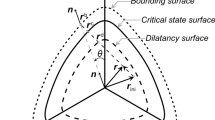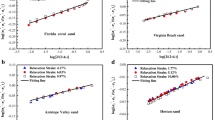Abstract
A constitutive model for sands in monotonic shear is presented. The model is designed to simulate the behavior of sands in the whole stress and strain range of engineering interest with enough accuracy for practical usage. Material parameters were chosen to be state independent and easy to calibrate using conventional testing procedures. The formulation is based on effective stresses, pressure-dependent hyperelasticity, non-associative elastoplasticity, an isotropic hardening law and Rowe’s stress-dilatancy theory. The implementation of Rowe’s stress-dilatancy theory within the framework of elastoplasticity theory is discussed. It is found that Rowe’s theory produces a volumetric plastic strain rate function that has a discontinuity in its first derivative w.r.t. stress, and a smoothed form is proposed instead. Finally, some experimental tests are simulated and the results are briefly discussed.





























Similar content being viewed by others
References
Been K, Jefferies G (1985) A state parameter for sands. Geotechnique 35(2):99–112
Benz T, Vermeer A, Schwab R (2008) A small-strain overlay model. Int J Numer Anal Meth Geomech. doi 10.1002/nag.701
Bolton M (1986) The strength and dilatancy of sands. Geotechnique 36(1):65–78
Bolton M (1987) The strength and dilatancy of sands: discussion. Geotechnique 37(2):219–226
Brinkgreve R, Broere W, Waterman D (2006) Plaxis users manual. ISBN-10: 90-76016-02-X
Casagrande A (1936) Characteristics of cohesionless soils affecting the stability of slopes and earth fills. J Boston Soc Civil Eng 23(1):13–32
Casagrande A (1975) Liquefaction and cyclic deformation of sands—a critical review. V PCSMFE Buenos Aires, Argentina, vol 5, pp 1–35
Cubrinovski M, Ishihara K (1998) Modelling of sand behaviour based on state concept. Soil Found 38(3):115–127
Dafalias Y, Popov E (1975) A model of nonlinearly hardening materials for complex loadings. Acta Mech 21:173–192
Dafalias Y, Manzari M (2004) Simple plasticity sand model accounting for fabric change effects. J Eng Mech 130(6):622–634
de Beer E (1965) Influence of the mean normal stress on the shearing resistance of sand. VI ICSMFE Montreal, Canada, vol 1, pp 165–169
Duncan J, Chang C (1970) Nonlinear analysis of stress and strain in soils. J Soil Mech Found Div ASCE 96(SM5):1629–1653
Fukushima S, Tatsuoka F (1984) Strength and deformation characteristics of saturated sand at extremely low pressures. Soil Found 24(4):30–48
Guo P, Stolle D (2004) The extension of Rowe’s stress-dilatancy model to general stress condition. Soil Found 44(4):1–10
Guo P, Wan R (2007) Rational approach to stress-dilatancy modelling using an explicit micromechanical formulation. In Bifurcations, Instabilities, Degradation in Geomechanics, Springer, doi 10.1007/978-3-540-49342-6_10
Hardin B, Richart F (1963) Elastic wave velocities in granular soils. J Soil Mech Found Div ASCE 89(SM1):33–65
Hardin B, Drnevich V (1972) Shear modulus and damping in soils: measurement and parameter effects. J Soil Mech Found Div ASCE 98(SM6):603–624
Ishihara K (1993) Liquefaction and flow failure during earthquakes. The 33rd Rankine lecture. Geotechnique 43:349–415
Jefferies M (1993) Nor-sand: a simple critical state model for sand. Geotechnique 43:91–103
Kim M, Lade P (1988) Single hardening constitutive model for frictional materials I. Plastic potential function. Comput Geotech 5(4):307–324
Kokusho T (1980) Cyclic triaxial test of dynamic soil properties for wide strain range. Soil Found 20(2):45–60
Kondner R (1963) Hyperbolic stress–strain response; cohesive soils. J Soil Mech Found Div ASCE 78(SM1):115–143
Lade P (1977) Elastoplastic stress–strain theory for cohesionless soil with curved yield surfaces. Int J Solids Struct 13:1019–1035
Lade P (1988) Double hardening constitutive model for soils: parameter determination and predictions for two sands. Proc. cleveland workshop const Eq granular non-cohesive soils, pp 367–382
Lade P, Kim M (1988) Single hardening constitutive model for frictional materials II. Yield criterion and plastic work contours. Comput Geotech 6(1):13–30
Lade P, Kim M (1988) Single hardening constitutive model for frictional materials III. Comparison with experimental data. Comput Geotech 6(1):31–48
Lee K, Seed H (1967) Drained strength characteristics of sands. J Soil Mech Found Div ASCE 93(SM6):117–141
Maeda K, Miura K (1999) Confining stress dependency of mechanical properties of sands. Soil Found 39(1):53–67
Maeda K, Miura K (1999) Relative density dependency of mechanical properties of sands. Soil Found 39(1):69–79
Manzari M, Dafalias Y (1997) A two-surface critical plasticity model for sand’. Geotechnique 47(2):255–272
Matsuoka H, Nakai T (1974) Stress-deformation and strength characteristics of soil under three different principal stresses. Proc Jpn Soc Civil Eng 233:59–70
Molenkamp F (1988) A simple model for isotropic non-linear elasticity of frictional materials. Int J Numer Anal Meth Geomech 12(5):467–475
Núñez E (1991) Propiedades mecánicas de materiales granulares incoherentes. Acad Nac Cs Ex Fís Nat Buenos Aires 46:71–89
Pestana J, Whittle A (1995) Compression model for cohesionless soils. Geotechnique 45(4):611–631
Pestana J, Whittle A, Salvati L (2002) Evaluation of a constitutive model for clays and sands: Part I—sand behaviour. Int J Numer Anal Meth Geomech 26(2):1097–1121
Poulos S (1981) The steady state of deformation. J Geot Eng Div ASCE 107(5):553–562
Richart F, Hall J, Woods D (1970) Vibrations of soils and foundations. Int Series Theo Appl Mech. Prentice-Hall, Englewood Cliffs, p 414
Rowe P (1962) The stress dilatancy relation for static equilibrium of an assembly of particles in contact. Proc Royal Soc 269:500–527
Rowe P (1971) Stress–strain relationships for particulate materials at equilibrium. Proc Perf Earth Earth Support Struct 3:327–359
Santamarina JC, Cascante G (1996) Stress anisotropy and wave propagation—a micromechanical review. Can Geot J 33:770–782
Santamarina JC (2001) Soils and waves. Wiley ISBN 978-0-471-49058-6
Schanz T, Vermeer P, Bonnier P (1999) The hardening soil model: formulation and verification. Proc Plaxis Symp Beyond 2000 Comp Geotech Balkema, The Netherlands, pp 55–58
Sfriso A (2007) A constitutive model for sands: Evaluation of predictive capability. Proc XIII CPMS, pp 242–247
Sfriso A (2008) Numerical assessment of the deformation of CFRD dams during earthquakes. Proc XII IACMAG 4054: 4061
Sfriso A (2009) The friction angle and dilatancy of sands. XVII ICSMGE, Alexandria, Egypt, pp 433–435
Tatsuoka F, Shibuya S (1992) Deformation characteristics of soils and rocks from field and laboratory tests. Inst Ind Sc U Tokio 37(1), N° 235, 136 p
Tatsuoka F, Siddiquee M, Park C, Sakamoto M, Abe F (1993) Modelling stress strain relations of sand. Soil Found 33(2):60–81
Teachavorasinskum S, Shibuya S, Tatsuoka F (1991) Stiffness of sands in monotonic and cyclic loading in simple shear. Proc ASCE Geot Eng Congress Boulder, vol 1, pp 7863–7878
Trautmann C, Kulhawy F (1987) CUFAD—A computer program for compression and uplift foundation analysis and design. Report EPRI EL-4540-CCM
Verdugo R, Ishihara K (1996) The steady state of sandy soils. Soil Found 36(2):81–91
Wan R, Guo P (1999) A pressure and density dependent dilatancy model for granular materials. Soil Found 39(6):1–11
Wanatowski D, Chu J (2006) Strain softening of K0-consolidated Changi sand under plane strain conditions. Acta Geotech I:29–42. doi:10.1007/s11440-006-0004-x
Woodward P, Molenkamp F (1999) Application of an advanced multi surface kinematic constitutive soil model. Int J Numer Anal Meth Geomech 23(15):1995–2043
Yamashita S, Jamiolkowski M, Lo Presti D (2000) Stiffness nonlinearity of three sands. J Geot Geoenv Eng ASCE 126(10):929–938
Acknowledgments
The first author gratefully acknowledges many valuable suggestions, discussions and advice given by Prof. Eduardo Núñez.
Author information
Authors and Affiliations
Corresponding author
Rights and permissions
About this article
Cite this article
Sfriso, A., Weber, G. Formulation and validation of a constitutive model for sands in monotonic shear. Acta Geotech. 5, 257–272 (2010). https://doi.org/10.1007/s11440-010-0127-y
Received:
Accepted:
Published:
Issue Date:
DOI: https://doi.org/10.1007/s11440-010-0127-y




